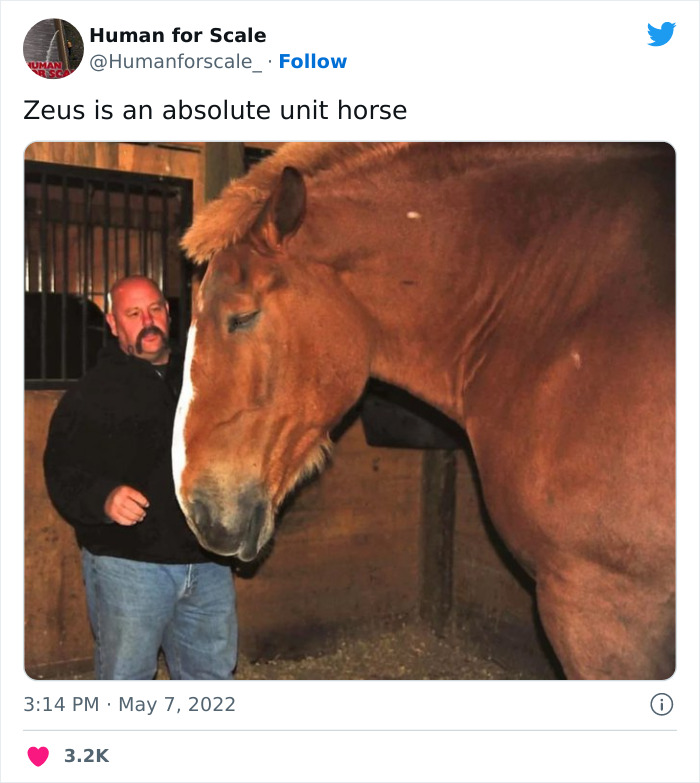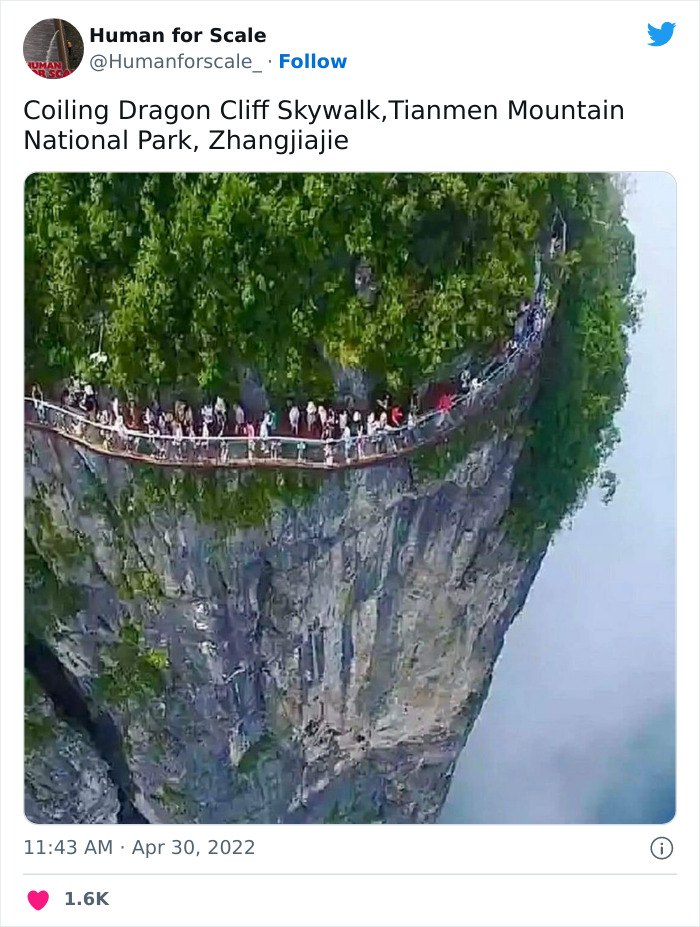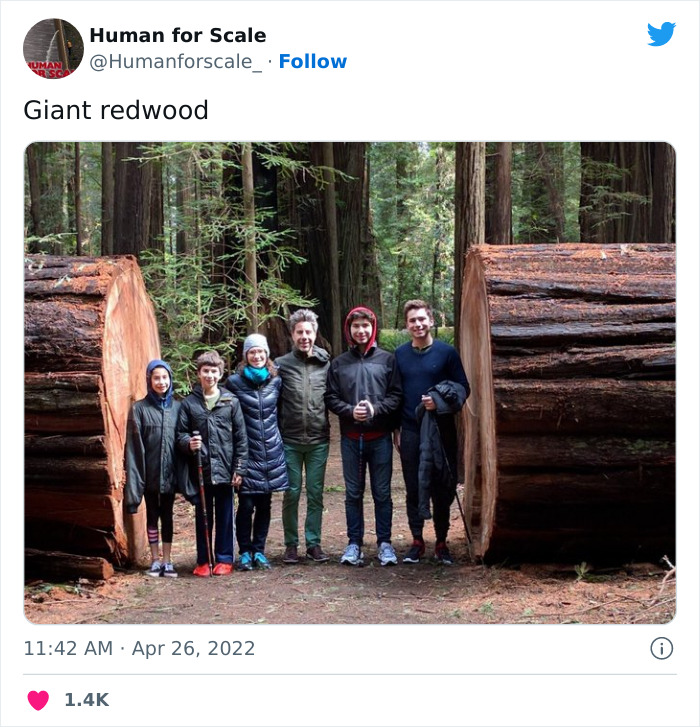If you’re tired of measuring everything in geese feet and kidney stones—that’s what the imperial system measures things with, right?—then there’s a new alternative to this, and that is humans.
Yep, humans have become a new measuring scale for things, no matter big or small. You just need to make sure one such human is in frame of whatever colossal or minuscule thing that you are taking a picture of and wham! you got a picture with a human for scale.
Wait, what…? The metric system? Don’t be silly.
Anywho, turns out, there is a Twitter page dedicated to sharing photographs with mostly gargantuan, but sometimes teeny-tiny structures, items or beings with a human conveniently somewhere in the visual composition so that you can grasp the scale of things.
Bored Panda has compiled a list of the best tweets published by the Twitter account into a neat little list that you can find below. And if you’re going down that way, do click every single upvote button along the way (OK, well, not every single one, but definitely the ones you like, and definitely click, because smashing it might cause irreversible damage to your human interface device of choice).
More Info: Twitter
#1
#2
#3
According to Twitter, the Human For Scale page was created earlier this year (in April of 2022, for those reading this in the future. Also, hi, leave a comment letting us know if cars can fly yet). In that time, it has managed to amass quite a following—105,000 followers as of this article.
The name of the Twitter page more or less says it all, but the additionally provided description adds that it’s dedicated to photos that feature humans to “aid the eye in determining the size of things.”
However, you could argue that there is more to it as the contents of the page often display photos of unusually, incredibly, or surprisingly large things, next to which a human looks like a 13-pixel speck you’d be inclined to scratch off your monitor thinking it’s your sibling’s dried-up spit bubble. So, be amazed!
#4
#5
#6
And speaking of the contents, the Human For Scale page features ROUS versions of things—things that look unusually large. You’ve got marvels of human engineering (towers, ancient buildings, statues, that one submarine of epic proportions, etc.), living creatures (whales, crabs, snails, and the like), as well as wonders of nature (cliff-sides, crevices, planets, that sort of deal) among many other things featured. And it’s all with varying degrees of human in them.
Some of the most successful tweets on the page have upwards of 100K likes, with your average tweet being in the thousands. Oh, and if you’re wondering, the most liked tweet is this one with a photo of two people sitting on the Abraj Al Bait clock tower in Mecca.
#7
#8
#9
#10
Pages like Human For Scale have a certain kind of randomness factor to them. If you’ve been on the internet long enough, you’ve already understood that based on the numerous pages like this already out there. So, we asked Cohen why is the internet seemingly the best place for such content.
“Human For Scale is random in as much as Weird Video Game Ads, Shirts With Threatening Auras, or Tweets of Cats. These theme accounts tap into the desire for viral content—low risk content that is easily shareable with people outside our own hyper-specific internet affinity groups. It’s a tale as old as the internet and really reminds us of a time when everything wasn’t a meme, but could just be a fun thing to like on our timeline. The internet is the only place for this content, because traditional media doesn’t have this capability. It’s what puts the social in social media.”
#11
#12
#13
#14
#15
So, given such content, what does this tell us about the average internet dweller? According to Cohen, Average Internet Joe is a scroller, a surfer, a commenter, or [insert whatever other more-or-less passive descriptor here]. Most who consume the internet on apps like Twitter and Facebook are not influencers or internet personalities—they’re just there to kill time, enjoy easily-digestible content, and use social media for it’s perceived purpose of making media social…
“… which, as we know, isn’t true, since social media is a user network utilizing algorithms to create feeds to sell advertising,” pointed out Cohen. “Another thing is these random pages are usually part of a network of posters (sometimes called ‘Tweetdeckers’) that run these accounts because they know that their agnostic, apolitical content will be seen by as many people as possible. Usually, it comes into your feed because a friend liked the post or Twitter put it in a ‘viral tweets’ category.”
Does anyone else feel like they’ve just escaped the Matrix after that?
#16
#17
#18
#19
#20
Considering all of this, it leads us to a very crucial point of what it means to be a responsible and safe consumer of the internet. And that is what Cohen calls internet literacy:
“It’s really important for us to increase our internet literacies and recognize that very often, viral content is gamed and optimized. The viral account holders (‘tweetdeckers’) are usually in it to make money, drawing large amounts of likes and followers so they can post sponsored content or cross promote other accounts for profit.”
“As with culture, there will always be people who take advantage of the current flows of entertainment and information systems for financial gain. If people become better at reading the internet as a system, we’re far less likely to fall down rabbit holes. I’m not saying that Humans for Scale is acting in bad faith, but many viral accounts slowly crank up the weirdness/randomness until the algorithm suggests some questionable content.”
#21
#22
#23
#24
#25
“There will always be viral content that fascinates people, but with anything, it only takes a quick second to make sure that viral post isn’t attached to some account that is spreading misinformation or mean spirited content. It’s easy to like a post, but always remember that your likes on Twitter end up in other people’s feeds,” concluded Cohen.
#26
#27
#28
#29
#30
So, if you have been paying attention and dotting down good notes, you’ll know well enough where to draw that line in this article. And you know what, we respect that.
But I do have to say that here is the link to the original Twitter page for Human for Scale, if you want to check out more, and here is another fun list we’ve crafted that’s less about humans as tools of measurement and more about car license plates that might just make you chuckle more than usual.
And most definitely be sure to visit James Cohen’s website and give his Twitter a follow to learn more of his works, projects, and wisdom on the contemporary digital culture and the internet as we know it today.
Oh, and upvote, comment, do all that jazz. Or don’t. Your call!
















































 Photographer Finds Locations Of 1960s Postcards To See How They Look Today, And The Difference Is Unbelievable
Photographer Finds Locations Of 1960s Postcards To See How They Look Today, And The Difference Is Unbelievable  Hij zet 3 IKEA kastjes tegen elkaar aan en maakt dit voor zijn vrouw…Wat een gaaf resultaat!!
Hij zet 3 IKEA kastjes tegen elkaar aan en maakt dit voor zijn vrouw…Wat een gaaf resultaat!!  Scientists Discover 512-Year-Old Shark, Which Would Be The Oldest Living Vertebrate On The Planet
Scientists Discover 512-Year-Old Shark, Which Would Be The Oldest Living Vertebrate On The Planet  Hus til salg er kun 22 kvadratmeter – men vent til du ser det indvendigt
Hus til salg er kun 22 kvadratmeter – men vent til du ser det indvendigt  Superknepet – så blir snuskiga ugnsformen som ny igen!
Superknepet – så blir snuskiga ugnsformen som ny igen!  Meteorite That Recently Fell in Somalia Turns Out to Contain Two Minerals Never Before Seen on Earth
Meteorite That Recently Fell in Somalia Turns Out to Contain Two Minerals Never Before Seen on Earth  Nearly Frozen Waves Captured On Camera By Nantucket Photographer
Nearly Frozen Waves Captured On Camera By Nantucket Photographer  It’s Official: Astronomers Have Discovered another Earth
It’s Official: Astronomers Have Discovered another Earth 